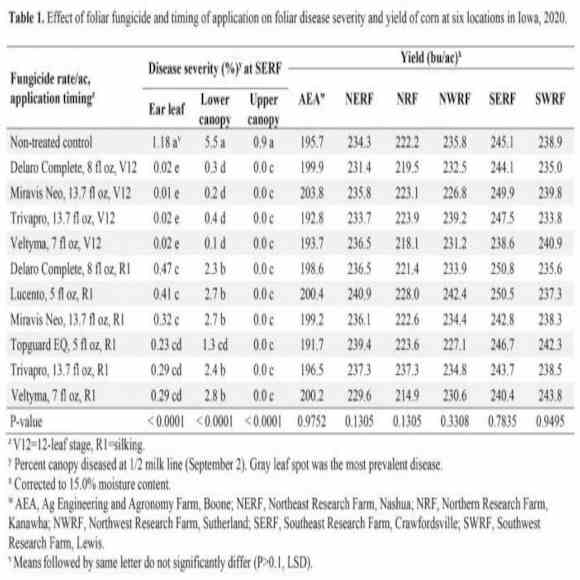By Dr. Alison Robertson
This article summarizes 2020 corn foliar fungicide trials that were done at six locations in Iowa: ISU Northwest Research and Demonstration Farm (NWRF), Sutherland; Northeast Research and Demonstration Farm (NERF), Nashua; Northern Research and Demonstration Farm (NRF), Kanawha; Southwest Research and Demonstration Farm (SWRF), Lewis; Southeast Research and Demonstration Farm (SERF), Crawfordsville; and the Ag Engineering and Agronomy Farm (AEA) near Boone.
As in years past, these trials were done to provide data to farmers to help determine if a foliar fungicide was necessary. Our objectives were 1) assess the effect of timing of application of fungicides on disease, 2) evaluate the yield response of hybrid corn to foliar fungicide application, and 3) discern differences, if any, between fungicide products.
Products used and application timings tested
Six products at various application timings were evaluated (Table 1). Fungicides were applied at growth stage V12 and/or R1 based on the company’s suggestions. No surfactant was included in applications made at V12.

Effect of product and timing on foliar disease
- Percent disease in the canopy below the ear leaf, the ear leaf, and the canopy above was estimated visually at R5 (Table 1).
- Disease severity was very low (<1% severity on the ear leaf of the control plots) at AEA, NRF, NERF, NWRF and SWRF due to drier conditions during grainfill across the state.
- No effect of fungicide on disease was detected at AEA, NRF, NERF, NWRF and SWRF.
- At SERF, GLS severity in the lower canopy of the control plots was 5.5%,
- Fungicides reduced GLS at SERF (P<0.1; Table 1).
- Applications at V12 reduced disease severity in the lower canopy more than applications made at R1.
- Other diseases observed included common rust (all locations), southern rust (all locations), and tar spot (NERF and SERF). All were present at trace levels (<0.1% of the canopy affected).
Effect of product and timing on yield
- Yields of the non-sprayed check ranged from 195.7 bu/A at AEA to 245.1 bu/A at NWRF (Table 1).
- No effect of fungicide on yield was detected (P>0.1)
Management recommendations
- All fungicides in these trials were effective against gray leaf spot. For a list of fungicides effective against GLS and all diseases on corn, the following publication “Fungicide efficacy for corn diseases” is available from the Crop Protection Network. This publication is updated annually by corn pathologists across the U.S. and Ontario, Canada.
- Applications at V12 reduced GLS severity more than applications made at R1. These data are similar to what we reported in 2017,where V12 applications also reduced GLS more than applications at R1.
- Remember GLS always starts in the lower canopy. With applications at V12, fungicides are more likely to reach the lower canopy and protect the lower leaves.
- Greater yields were not detected when a fungicide was applied.
- The extreme drought conditions that occurred limited disease development. In general, if GLS severity is greater than 5% on the ear leaf at R5, yield loss may be expected.
- There are other reports of no yield response of crops to fungicide applications in drought conditions from Pioneer and the University of Illinois.
Fungicide resistance
To limit resistance developing to fungicide chemistries, reserve fungicide applications for fields that are more likely to have disease, such as those planted to susceptible hybrids, low-lying fields where morning fogs often occur, or fields with a history of disease. Follow local extension pathologists and agronomists on social media to stay informed on diseases prevalent in your area, the risk of disease, and the need for a fungicide application.
Source : iastate.edu